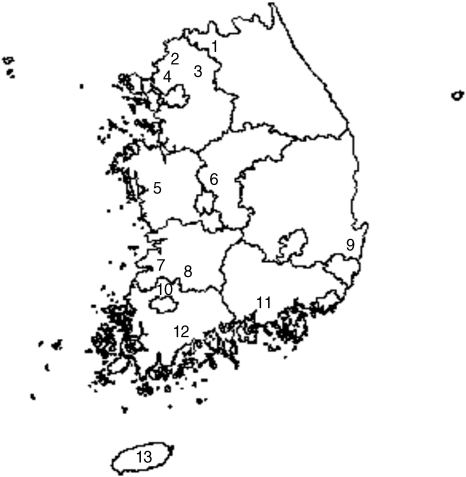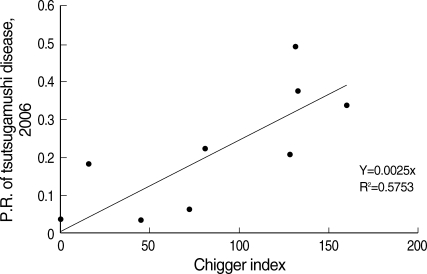Cited By
Citations to this article as recorded by

Molecular evidence of zoonotic Babesia species, other than B. microti, in ixodid ticks collected from small mammals in the Republic of Korea
Tae Yun Kim, Seong Yoon Kim, Tae‐Kyu Kim, Hee IL Lee, Shin‐Hyeong Cho, Wook‐Gyo Lee, Hyunwoo Kim
Veterinary Medicine and Science.2021; 7(6): 2427.
CrossRef Faunal analysis of chigger mites (Acari: Prostigmata) on small mammals in Yunnan province, southwest China
Pei-Ying Peng, Xian-Guo Guo, Tian-Guang Ren, Wen-Yu Song
Parasitology Research.2015; 114(8): 2815.
CrossRef Ectoparasitic chigger mites on large oriental vole (Eothenomys miletus) across southwest, China
Pei-Ying Peng, Xian-Guo Guo, Wen-Yu Song, Peng Hou, Yun-Ji Zou, Rong Fan
Parasitology Research.2016; 115(2): 623.
CrossRef An updated distribution and hosts: trombiculid mites (Acari: Trombidiformes) associated with small mammals in Yunnan Province, southwest China
Pei-Ying Peng, Xian-Guo Guo, Tian-Guang Ren, Wen-Ge Dong, Wen-Yu Song
Parasitology Research.2016; 115(5): 1923.
CrossRef Species diversity of ectoparasitic chigger mites (Acari: Prostigmata) on small mammals in Yunnan Province, China
Pei-Ying Peng, Xian-Guo Guo, Tian-Guang Ren, Wen-Yu Song, Wen-Ge Dong, Rong Fan
Parasitology Research.2016; 115(9): 3605.
CrossRef AuNPs/CNF-modified DNA biosensor for early and quick detection of O. tsutsugamushi in patients suffering from scrub typhus
Deepak Kala, Tarun Kumar Sharma, Shagun Gupta, Rupak Nagraik, Vivek Verma, Atul Thakur, Ankur Kaushal
A cross sectional study on molecular prevalence of Orientia tsutsugamushi in household rat population of South India
S. Purushothaman, P. Azhahianambi, M. Dharman, R. Gokula Kannan, K.G. Tirumurugaan, C. Soundararajan, R.P. Aravindh Babu, Panneer Devaraju, John A.J. Prakash
Comparative Immunology, Microbiology and Infectious Diseases.2024; 111: 102212.
CrossRef Associations of meteorological factors and dynamics of scrub typhus incidence in South Korea: A nationwide time-series study
Taehee Chang, Kyung-Duk Min, Sung-il Cho, Yoonhee Kim
Environmental Research.2024; 245: 117994.
CrossRef Epidemiological Characteristics of Scrub Typhus in Korea, 2009
Sunja Kim, Jin Seok Kim, Hagyung Lee
Osong Public Health and Research Perspectives.2010; 1(1): 55.
CrossRef Epidemiological characteristics and spatiotemporal patterns of scrub typhus in Yunnan Province from 2006 to 2017
Pei-Ying Peng, Lei Xu, Gu-Xian Wang, Wen-Yuan He, Ting-Liang Yan, Xian-Guo Guo
Climate influences scrub typhus occurrence in Vellore, Tamil Nadu, India: analysis of a 15-year dataset
Solomon D’Cruz, Kotamreddy Sreedevi, Cheryl Lynette, Karthik Gunasekaran, John Antony Jude Prakash
Distribution and host selection of the chigger mite vector of scrub typhus,Leptotrombidium deliense, in southwest China
Yan Lv, Xian-Guo Guo, Dao-Chao Jin, Rong Fan, Cheng-Fu Zhao, Zhang-Wei Zhang, Ke-Yu Mao, Wen-Yu Song, Wen-Ge Dong, Ti-Jun Qian, Zhi-Hua Yang
International Journal of Acarology.2021; 47(3): 233.
CrossRef Occurrence rates of wild rodent hosts and chigger mites and the infection rate of Orientia tsutsugamushi in the central region of South Korea from 2015 to 2018
Moon Bo Choi, Yeongbu Kim, Da Young Kim, Ohseok Kwon
Entomological Research.2019; 49(8): 374.
CrossRef Three‐year surveillance (2016–2018) of chigger mites vector for tsutsugamushi disease in the Hwaseong‐Si area of Gyeonggi‐Do, Republic of Korea
Hojong Jun, Seung Jegal, Myung‐Deok Kim‐Jeon, Jong Yul Roh, Wook‐Gyo Lee, Seo Hye Park, Seong Kyu Ahn, Jinyoung Lee, Young Woo Gong, Mun Ju Kwon, Young Yil Bahk, Tong‐Soo Kim
Entomological Research.2020; 50(2): 63.
CrossRef Bimonthly surveillance of wild rodents and chigger mites in urban parks in Daegu from 2018 to 2019
Yeong Bu Kim, Moon Bo Choi, Ohseok Kwon
Entomological Research.2020; 50(12): 609.
CrossRef Epidemiological characteristics of cases with scrub typhus and their correlation with chigger mite occurrence (2019–2021): A focus on case occupation and activity locations
Se‐Jin Jeong, Jin‐Hwan Jeon, Kyung won Hwang
Entomological Research.2023; 53(7): 247.
CrossRef Detection of US and Kobe‐type Babesia microti in ticks collected from small mammals of the Republic of Korea
Tae Yun Kim, Seong Yoon Kim, Jiye Seo, Hee IL Lee, Wook‐Gyo Lee, Hyunwoo Kim
Entomological Research.2024;[Epub]
CrossRef Abundances and host relationships of chigger mites in Yunnan Province, China
Y.‐Z. ZHAN, X.‐G. GUO, J. R. SPEAKMAN, X.‐H. ZUO, D. WU, Q.‐H. WANG, Z.‐H. YANG
Medical and Veterinary Entomology.2013; 27(2): 194.
CrossRef Analysis of ectoparasites (chigger mites, gamasid mites, fleas and sucking lice) of the Yunnan red‐backed vole (Eothenomys miletus) sampled throughout its range in southwest China
P.‐Y. PENG, X.‐G. GUO, W.‐Y. SONG, P. HOU, Y.‐J. ZOU, R. FAN, X.‐S. HE
Medical and Veterinary Entomology.2015; 29(4): 403.
CrossRef Meteorological factors and risk of scrub typhus in Guangzhou, southern China, 2006–2012
Tiegang Li, Zhicong Yang, Zhiqiang Dong, Ming Wang
BMC Infectious Diseases.2014;[Epub]
CrossRef Surveillance of potential hosts and vectors of scrub typhus in Taiwan
Chi-Chien Kuo, Pei-Lung Lee, Chun-Hsung Chen, Hsi-Chieh Wang
Parasites & Vectors.2015;[Epub]
CrossRef Urbanization of Scrub Typhus Disease in South Korea
Sang-Won Park, Na-Young Ha, Boyeong Ryu, Ji Hwan Bang, Hoyeon Song, Yuri Kim, Gwanghun Kim, Myoung-don Oh, Nam-Hyuk Cho, Jong-koo Lee, Darren J. Gray
PLOS Neglected Tropical Diseases.2015; 9(5): e0003814.
CrossRef Coincidence between Geographical Distribution of Leptotrombidium scutellare and Scrub Typhus Incidence in South Korea
Jong Yul Roh, Bong Gu Song, Won Il Park, Eun Hee Shin, Chan Park, Mi-Yeoun Park, Kyu Sik Chang, Wook Gyo Lee, Hee Il Lee, E-Hyun Shin, Xue-jie Yu
Landscapes with different biodiversity influence distribution of small mammals and their ectoparasitic chigger mites: A comparative study from southwest China
Pei-Ying Peng, Xian-Guo Guo, Dao-Chao Jin, Wen-Ge Dong, Ti-Jun Qian, Feng Qin, Zhi-Hua Yang, Rong Fan, Ulrike Gertrud Munderloh
PLOS ONE.2018; 13(1): e0189987.
CrossRef Prevalence of Orientia tsutsugamushi, Anaplasma phagocytophilum and Leptospira interrogans in striped field mice in Gwangju, Republic of Korea
Mi-Seon Bang, Choon-Mee Kim, Jung Wook Park, Jae Keun Chung, Dong-Min Kim, Na Ra Yun, Kalimuthusamy Natarajaseenivasan
PLOS ONE.2019; 14(8): e0215526.
CrossRef Analysis of epidemiological characteristics of four natural-focal diseases in Shandong Province, China in 2009-2017: A descriptive analysis
Rui Chen, Zengqiang Kou, Liuchen Xu, Jie Cao, Ziwei Liu, Xiaojing Wen, Zhiyu Wang, Hongling Wen, Isaac Chun-Hai Fung
PLOS ONE.2019; 14(8): e0221677.
CrossRef Species abundance distribution and ecological niches of chigger mites on small mammals in Yunnan province, southwest China
Pei-Ying Peng, Xian-Guo Guo, Dao-Chao Jin, Wen-Ge Dong, Ti-Jun Qian, Feng Qin, Zhi-Hua Yang
Distribution and Population Density of Rodents and Chigger Mites in Gokseong-gun of Jeollanam-do, Korea
Hyeonje Song
Korean Journal of Clinical Laboratory Science.2016; 48(3): 242.
CrossRef Distribution of Chigger Mites as Tsutsugamushi Vectors Sampled in Seogwipo
Hyeok Jae Lee, Chul Park
The Korean Journal of Clinical Laboratory Science.2019; 51(3): 344.
CrossRef Distribution Variations of Chigger Mites Collected in Jinan, Jeollabuk-do
Hyeok Jae Lee, Chul Park
Korean Journal of Clinical Laboratory Science.2021; 53(4): 317.
CrossRef Repellency of Cassia Bark, Eucalyptus, and Star Anise Oils and Their Major Constituents toLeptotrombidium pallidum(Acari: Trombiculidae)
E-Hyun Shin, Bong Gu Song, Hee Il Lee, Mi Yeoun Park, Young-Joon Ahn, Kyu-Sik Chang
Journal of Medical Entomology.2013; 50(3): 579.
CrossRef Geographical Distribution and Seasonal Indices of Chigger Mites on Small Mammals Collected on the East Coast of the Republic of Korea
Gab-Man Park, Ho-Sung Shin
Journal of Parasitology.2016; 102(2): 193.
CrossRef Annual Fluctuation in Chigger Mite Populations and <italic>Orientia Tsutsugamushi</italic> Infections in Scrub Typhus Endemic Regions of South Korea
Seong Yoon Kim, Byoungchul Gill, Bong Gu Song, Hyuk Chu, Won Il Park, Hee Il Lee, E-hyun Shin, Shin-Hyeong Cho, Jong Yul Roh
Osong Public Health and Research Perspectives.2019; 10(6): 351.
CrossRef Serosurveillance of Scrub Typhus in Small Mammals Collected from Military Training Sites near the DMZ, Northern Gyeonggi-do, Korea, and Analysis of the Relative Abundance of Chiggers from Mammals Examined
Heung Chul Kim, In Yong Lee, Sung Tae Chong, Allen L. Richards, Se Hun Gu, Jin-Won Song, John S. Lee, Terry A. Klein
The Korean Journal of Parasitology.2010; 48(3): 237.
CrossRef Larval Chigger Mites Collected from Small Mammals in 3 Provinces, Korea
In-Yong Lee, Hyeon-Je Song, Yeon-Joo Choi, Sun-Hye Shin, Min-Kyung Choi, So-Hyun Kwon, E-Hyun Shin, Chan Park, Heung-Chul Kim, Terry A. Klein, Kyung-Hee Park, Won-Jong Jang
The Korean Journal of Parasitology.2014; 52(2): 225.
CrossRef Seroepidemiological Survey of Zoonotic Diseases in Small Mammals with PCR Detection of Orientia tsutsugamushi in Chiggers, Gwangju, Korea
Jung Wook Park, Jae Keun Chung, Sun Hee Kim, Sun Ju Cho, Yi Deun Ha, So Hyang Jung, Hye Jung Park, Hyun Jae Song, Jung Yoon Lee, Dong Min Kim, Jah Pyus, Dong Ryong Ha, Eun Sun Kim, Jae Il Lee
The Korean Journal of Parasitology.2016; 54(3): 307.
CrossRef Catenotaenia dendritica (Cestoda: Catenotaeniidae) and Three Ectoparasite Species in the Red Squirrel, Sciurus vulgaris, from Cheongju, Korea
Seongjun Choe, Dongmin Lee, Hansol Park, Hyeong-Kyu Jeon, Youngsun Lee, Ki-Jeong Na, In-Yong Lee, Keeseon S. Eom
The Korean Journal of Parasitology.2016; 54(4): 509.
CrossRef Chigger Mite (Acari: Trombiculidae) Survey of Rodents in Shandong Province, Northern China
Xiao-Dan Huang, Peng Cheng, Yu-Qiang Zhao, Wen-Juan Li, Jiu-Xu Zhao, Hong-Mei Liu, Jing-Xuan Kou, Mao-Qing Gong
The Korean Journal of Parasitology.2017; 55(5): 555.
CrossRef Surveillance of Chigger Mite Vectors for Tsutsugamushi Disease in the Hwaseong Area, Gyeonggi-do, Republic of Korea, 2015
Young Yil Bahk, Hojong Jun, Seo Hye Park, Haneul Jung, Seung Jegal, Myung-Deok Kim-Jeon, Jong Yul Roh, Wook-Gyo Lee, Seong Kyu Ahn, Jinyoung Lee, Kwangsig Joo, Young Woo Gong, Mun Ju Kwon, Tong-Soo Kim
The Korean Journal of Parasitology.2020; 58(3): 301.
CrossRef Infestation and Related Ecology of Chigger Mites on the Asian House Rat (Rattus tanezumi) in Yunnan Province, Southwest China
Fan Ding, Wen-Li Jiang, Xian-Guo Guo, Rong Fan, Cheng-Fu Zhao, Zhi-Wei Zhang, Ke-Yu Mao, Rong Xiang
The Korean Journal of Parasitology.2021; 59(4): 377.
CrossRef Geographical Distribution and Epidemiologic Factors of Chigger Mites on Apodemus agrarius during Autumn in Korea
In Yong Lee, Jae-Won Lim, Jang Hoon Seo, Heung Chul Kim, Ku Jae Lee, Tai-Soon Yong, Won-Ja Lee, Jae-Ran Yu, Seobo Sim
The Korean Journal of Parasitology.2021; 59(5): 473.
CrossRef Prevalence of chigger mites and Orientia tsutsugamushi strains in northern regions of Gangwon-do, Korea
Soojin Kim, In Yong Lee, Sezim Monoldorova, Jiro Kim, Jang Hoon Seo, Tai-Soon Yong, Bo Young Jeon
Parasites, Hosts and Diseases.2023; 61(3): 263.
CrossRef Nationwide Incidence of Chigger Mite Populations and Molecular Detection of Orientia tsutsugamushi in the Republic of Korea, 2020
Min-Goo Seo, Bong-Goo Song, Tae-Kyu Kim, Byung-Eon Noh, Hak Seon Lee, Wook-Gyo Lee, Hee Il Lee
Microorganisms.2021; 9(8): 1563.
CrossRef Scrub Typhus: Historic Perspective and Current Status of the Worldwide Presence of Orientia Species
Allen L. Richards, Ju Jiang
Tropical Medicine and Infectious Disease.2020; 5(2): 49.
CrossRef History of Tsutsugamushi Disease in Korea
Moon-Hyun Chung, Jae-Seung Kang
Infection & Chemotherapy.2019; 51(2): 196.
CrossRef Unusual Genotypic Distribution of Orientia tsutsugamushi Strains Causing Human Infections on Jeju Island
Young-Sang Koh, Jeong Rae Yoo, Sohyun Kim, Seok Kim, Sang Taek Heo
The American Journal of Tropical Medicine and Hygiene.2014; 90(3): 507.
CrossRef Effect of Latitude and Seasonal Variation on Scrub Typhus, South Korea, 2001–2013
Seok-Won Kim, Dong-Min Kim, Ye Sul Jeung, Na Ra Yun, Mi Ah Han, Choon-Mee Kim
The American Journal of Tropical Medicine and Hygiene.2016; 94(1): 22.
CrossRef Molecular Epidemiology of an Orientia tsutsugamushi Gene Encoding a 56-kDa Type-Specific Antigen in Chiggers, Small Mammals, and Patients from the Southwest Region of Korea
Jung Wook Park, Sun Hee Kim, Duck Woong Park, So Hyang Jung, Hye Jung Park, Mi Hee Seo, Hyeon Je Song, Jung Yoon Lee, Dong Min Kim, Choon-Mee Kim, Byong Chul Gill, Hang Jin Jeong, Jeong Min Lee, Dong Ryong Ha, Eun Sun Kim, Jae Keun Chung
The American Journal of Tropical Medicine and Hygiene.2018; 98(2): 616.
CrossRef Ecological characteristics and current status of infectious disease vectors in South Korea
Dong-Kyu Lee
Journal of the Korean Medical Association.2017; 60(6): 458.
CrossRef Environmental survey on the vectors and hosts of Tsutsugamushi disease in Jeonnam province, Korea
Hyeon-Je Song
Korean Journal of Veterinary Service.2012; 35(3): 183.
CrossRef Epidemiology of Scrub Typhus and the Eschars Patterns in South Korea from 2008 to 2012
Ji-Hyuk Park, Sun-Ja Kim, Seung-Ki Youn, Kisoo Park, Jin Gwack
Japanese Journal of Infectious Diseases.2014; 67(6): 458.
CrossRef



